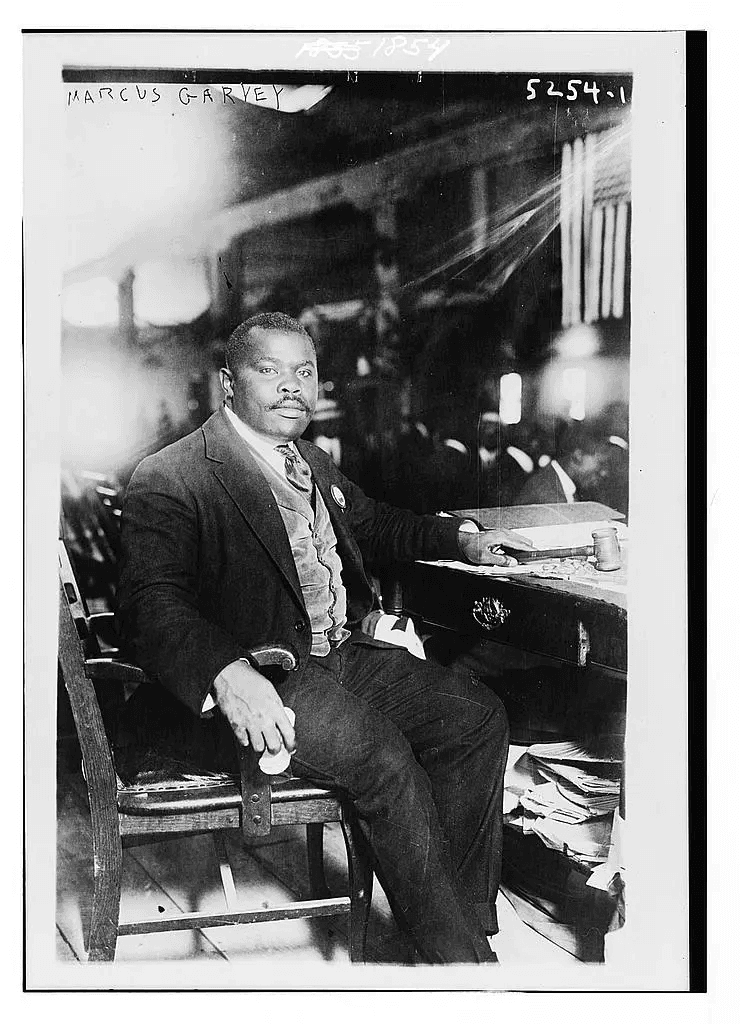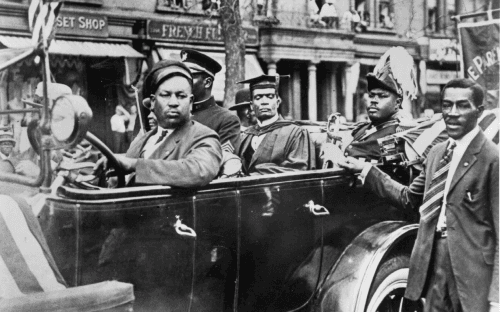The Universal Negro Improvement Association
Adam King
9 min read
Listen to this study note
Study Guide Overview
This study guide covers Marcus Garvey, the UNIA, and the Back-to-Africa Movement, focusing on their goals (e.g., Black nationalism, self-reliance, liberation), methods (e.g., Black Star Line, Negro Factories Corporation), and impact on African American identity and later movements. It includes analysis of Garvey's speeches and photos, plus practice questions for the AP exam.
#AP African American Studies: Ultimate Study Guide 🚀
Hey there! Let's get you prepped for the AP exam. This guide is designed to make sure you feel confident and ready to ace it. We'll break down everything you need to know, focusing on the big ideas and how they connect. Let's dive in!
#1. The Rise of Pan-Africanism and the UNIA
#1.1. UNIA's Pan-African Movement
-
What it was: The Universal Negro Improvement Association (UNIA), founded by Marcus Garvey, was the largest pan-African movement in African American history. It aimed to unite people of African descent globally. 🌍
-
Key Figure: Marcus Garvey, a Jamaican-born Black nationalist leader, was the driving force behind the UNIA.
Garvey's charisma and powerful speeches were key to the movement's success.
-
Global Reach: The UNIA had a massive international presence, with thousands of members across the Caribbean, Latin America, and Africa. 🗺️
-
Core Goals:
- Promote unity, pride, and self-reliance among African Americans.
- Challenge white supremacy through economic and political empowerment. 💪
-
Methods:
- Established businesses like the Negro Factories Corporation.
- Founded institutions like Liberty University.
- Organized international conventions, such as the 1920 International Convention of the Negro Peoples of the World. 🤝
The UNIA's broad international scope and focus on economic empowerment are crucial points to remember.
#1.2. The Back-to-Africa Movement
-
"Africa for the Africans": This was the slogan of Garvey's Back-to-Africa movement. It advocated for the repatriation of African Americans to their ancestral homeland. 💡
-
Why? Garvey believed that true freedom and equality were impossible for Black people in the United States due to systemic racism.
Don't confuse this with integrationist views of other civil rights leaders.
-
Vision: To establish independent Black nations in Africa, free from colonial rule. 🌍
-
Black Star Line: In 1919, Garvey founded the Black Star Line, a steamship company, to transport African Americans to Africa. 🚢
- The Black Star Line had three ships: SS Yarmouth, SS Shady Side, and SS Kanawha.
- It aimed to promote trade and commerce between Africa and the African diaspora. 💰
#2. Impact of Garvey and the UNIA
#2.1. Embracing African Heritage
-
Pride and Identity: The UNIA inspired African Americans to embrace their African heritage and take pride in their racial identity, especially during the era of intense racial violence and Jim Crow laws. ✊🏾
-
Cultural Expression:
- Promoted the wearing of African-inspired clothing. 👘
- Encouraged the adoption of African names.
- Championed the study of African history and civilizations (e.g., ancient Egypt, Mali Empire). 📚
-
Self-Determination: The UNIA advocated for the creation of separate Black institutions to foster industrial, political, and educational advancement.
This separatist approach was a key feature of Garvey's ideology.
- Economic Independence: Garvey believed in the importance of Black-owned businesses, schools, and political organizations for achieving true independence. 🏦
#2.2. UNIA's Black Liberation Objective
-
Global Liberation: The UNIA aimed to achieve Black liberation from colonialism and oppression across the African diaspora, including Africa, the Caribbean, and the Americas. 🌍
-
End Colonial Rule: The UNIA called for the end of European colonial rule in Africa and the establishment of independent Black nations. 🚩
-
Equal Rights: The UNIA demanded an end to racial discrimination and segregation in the United States and advocated for equal rights for African Americans. ⚖️
-
Influence:
-
Provided a framework for Black nationalism that influenced later movements. Understanding this influence is key for FRQs.
-
Inspired future Black leaders like Malcolm X and Stokely Carmichael and organizations like the Nation of Islam and the Black Panther Party. 🔥
-
Inspired the Rastafari movement in Jamaica, which saw Garvey as a prophet. 🦁
-
-
Symbolism:
- Created the red, black, and green flag as a symbol of Black pride and unity. 🖤❤️💚
- Red: Blood shed for liberation.
- Black: The color of African people.
- Green: The natural wealth of Africa.
- The flag was adopted by several African countries after gaining independence. 🇰🇪🇲🇼
- Created the red, black, and green flag as a symbol of Black pride and unity. 🖤❤️💚
#3. Required Sources
#3.1. "Address to the Second UNIA Convention" by Marcus Garvey, 1921
-
Context: This speech was a pivotal moment for the Pan-African movement, showcasing Garvey's powerful oratory and vision of Black self-reliance and repatriation. 🗣️
-
Key Themes:
- Call for African Liberation and Negro Emancipation: Garvey emphasized the urgency of liberating Africa and emancipating Negroes worldwide.
Remember the quote: "lay down, if needs be, the last drop of our blood for the defense of Africa and for the emancipation of our race."
- **Warning of Impending Racial Conflict:** Garvey warned of an upcoming racial conflict and urged Negroes to prepare.
Remember "handwriting is on the wall" - a warning of conflict.
- **Criticism of the League of Nations:** Garvey criticized the League for dividing African territories without consulting African people.
Remember, Garvey said they took "608,000 square miles of our own land" without asking.
- **Demand for Self-Governance:** Garvey asserted that Africans were capable of governing their own homeland. 🌍
- **Awakening of Negro Consciousness:** Garvey highlighted the emergence of a new, empowered Negro identity.
Remember, "The old Negro is buried" - a new era of pride.
- **Demand for Global Recognition:** Garvey demanded equal political standing for Negroes worldwide. ✊🏾
#3.2. Visual Sources: Marcus Garvey Photos
- Marcus Garvey at His Desk, 1924

-
Caption: This photo shows Garvey in a moment of work, highlighting his role as a leader and organizer. It reflects his dedication to the cause and his intellectual contributions to the movement.
-
Marcus Garvey in Harlem, 1924

- Caption: This image captures Garvey in a public setting, surrounded by supporters. It demonstrates the mass appeal of his movement and the strong sense of community he fostered.
When analyzing visual sources, pay attention to the setting, the people, and what the image conveys about the subject's role and influence.
#4. Final Exam Focus
- Highest Priority Topics:
-
The goals and methods of the UNIA. This is a frequent topic in both MCQs and FRQs.
-
The significance of the Back-to-Africa movement.
-
Garvey's philosophy of Black nationalism and self-determination.
-
The impact of the UNIA on subsequent Black liberation movements.
-
Analyzing primary source documents like Garvey's speeches.
-
Practice analyzing excerpts from Garvey's address.
- Common Question Types:
- Multiple Choice: Expect questions that test your knowledge of key figures, events, and concepts related to the UNIA and pan-Africanism.
- Short Answer: Be prepared to explain the goals and methods of the UNIA and its impact on African American identity and activism.
- Free Response: Be ready to analyze primary source documents, compare and contrast different approaches to Black liberation, and evaluate the long-term significance of the UNIA.
Practice writing thesis statements and topic sentences.
- Last-Minute Tips:
- Time Management: Quickly read through the questions and prioritize those you know best. Don't spend too long on any single question. ⏱️
- Common Pitfalls: Avoid oversimplifying complex issues. Be sure to provide specific evidence to support your claims.
Avoid vague generalizations - always back up your arguments with specifics.
- **Strategies:** For FRQs, start with a clear thesis statement and use topic sentences to organize your paragraphs. Always connect your analysis back to the question. ✍🏾
#5. Practice Questions
Practice Question
#Multiple Choice Questions
-
Which of the following best describes the primary goal of Marcus Garvey's Universal Negro Improvement Association (UNIA)? (A) To advocate for the integration of African Americans into white society. (B) To promote the establishment of independent Black nations in Africa. (C) To focus solely on economic development within the United States. (D) To work towards gradual civil rights reforms through legal channels.
-
The Black Star Line, founded by Marcus Garvey, was primarily intended to: (A) Promote racial integration in the United States. (B) Facilitate the transport of African Americans to Africa. (C) Serve as a symbol of Black economic power within the U.S. (D) Provide funding for civil rights organizations.
-
Which of the following is NOT a key element of Marcus Garvey's philosophy? (A) Black self-reliance and economic independence (B) The importance of embracing African heritage (C) The need for integration with white society (D) The call for Black liberation from colonialism and oppression
#Free Response Question (FRQ)
Question: Analyze the goals and methods of Marcus Garvey's Universal Negro Improvement Association (UNIA). In your response, be sure to discuss the significance of the Back-to-Africa movement and its impact on African American identity and activism. Use the provided documents and your knowledge of African American history to support your claims.
Document 1: "Address to the Second UNIA Convention" by Marcus Garvey, 1921
Document 2: Marcus Garvey at His Desk, 1924 (Image)
Scoring Breakdown:
-
Thesis (1 point): A clear, historically defensible thesis statement that addresses the goals and methods of the UNIA, the Back-to-Africa movement, and their impact on African American identity and activism.
-
Contextualization (1 point): Describes the broader historical context of racial discrimination and the rise of Black nationalism in the early 20th century.
-
Evidence from Documents (2 points): Uses specific evidence from the provided documents to support the analysis. For example:
- From Document 1: Quotes or references to Garvey's call for African liberation, self-governance, and the need for Black unity.
- From Document 2: Analysis of the image to show Garvey's leadership and focus on organizational work.
-
Evidence Beyond Documents (2 points): Provides additional evidence beyond the documents to support the analysis. For example:
- Discussion of the establishment of the Black Star Line and its purpose.
- Explanation of the UNIA's focus on economic empowerment and self-reliance.
- Mention of the UNIA's influence on future Black nationalist movements.
-
Analysis and Reasoning (2 points): Explains how the evidence supports the argument and demonstrates an understanding of the historical significance of the UNIA and the Back-to-Africa movement. For example:
- Analysis of how the UNIA's focus on Black pride and self-determination challenged white supremacy.
- Explanation of how the Back-to-Africa movement influenced African American identity and activism.
-
Complexity (1 point): Demonstrates a nuanced understanding of the topic by exploring complexities, contradictions, or alternative perspectives. For example:
- Acknowledging the criticisms of Garvey's movement and its limitations.
- Discussing the different views within the African American community regarding the Back-to-Africa movement.
You've got this! Remember, you're well-prepared, and you're going to do great. Good luck! 🎉
Continue your learning journey

How are we doing?
Give us your feedback and let us know how we can improve





